Efficient numerical algorithms for surface formulations of mathematical models for biomolecule analysis and design
Author(s)
Bardhan, Jaydeep Porter, 1978-
DownloadFull printable version (23.90Mb)
Other Contributors
Massachusetts Institute of Technology. Dept. of Electrical Engineering and Computer Science.
Advisor
Jacob K. White and Bruce Tidor.
Terms of use
Metadata
Show full item recordAbstract
This thesis presents a set of numerical techniques that extend and improve computational modeling approaches for biomolecule analysis and design. The presented research focuses on surface formulations of modeling problems related to the estimation of the energetic cost to transfer a biomolecule from the gas phase to aqueous solution. The thesis discusses four contributions to modeling biomolecular interactions. First, the thesis presents an approach to allow accurate discretization of the most prevalent mathematical definitions of the biomolecule-solvent interface; also presented are a number of accurate techniques for numerically integrating possibly singular functions over the discretized surfaces. Such techniques are essential for solving surface formulations numerically. The second part of the thesis presents a fast multiscale numerical algorithm, FFTSVD, that efficiently solves large boundary-element method problems in biomolecule electrostatics. The algorithm synthesizes elements of other popular fast algorithms to achieve excellent efficiency and flexibility. The third thesis component describes an integral-equation formulation and boundary-element method implementation for biomolecule electrostatic analysis. (cont.) The formulation and implementation allow the solution of complicated molecular topologies and physical models. Furthermore, by applying the methods developed in the first half of the thesis, the implementation can deliver superior accuracy for competitive performance. Finally, the thesis describes a highly efficient numerical method for calculating a biomolecular charge distribution that minimizes the free energy' change of binding to another molecule. The approach, which represents a novel PDE-constrained methodology, builds on well-developed physical theory. Computational results illustrate not only the method's improved performance but also its application to realistic biomolecule problems.
Description
Thesis (Ph. D.)--Massachusetts Institute of Technology, Dept. of Electrical Engineering and Computer Science, 2006. Includes bibliographical references (p. 179-183).
Date issued
2006Department
Massachusetts Institute of Technology. Department of Electrical Engineering and Computer SciencePublisher
Massachusetts Institute of Technology
Keywords
Electrical Engineering and Computer Science.